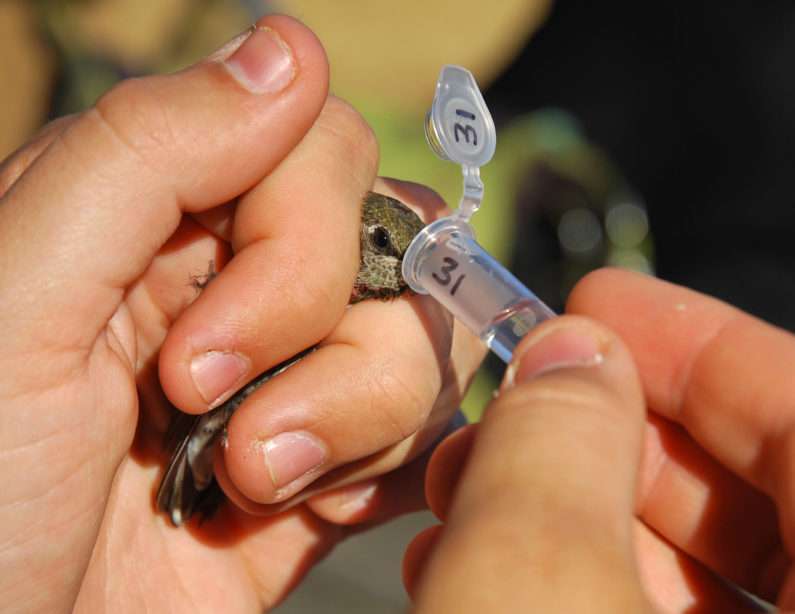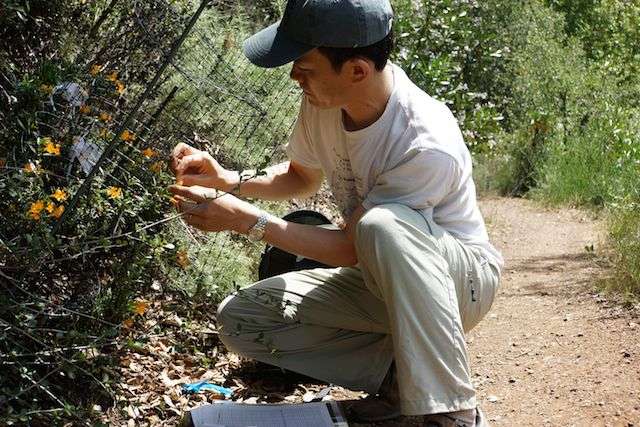Microbes in flower nectar affect pollination

Dipping its beak into the sweet nectar of a flower, a hummingbird is doing more than getting a meal – it's contributing to a microbial community that could potentially determine the fate of that flower. Recognizing that this fleeting interaction could have major implications on crop success and the health of pollinator species, the research group led by Tadashi Fukami, an associate professor of biology at Stanford, has studied the relationships between pollinators, microbes and plants for nearly a decade.
"Pollination is an important ecosystem service for people," said Fukami. "Microbes could be one of the missing pieces that we have to think about in order to understand more about pollination and what more we can do to make it efficient."
When Fukami came to Stanford in 2008, he was tasked with developing a new field biology class that would fit with other courses in the department focused on the study of yeast. Hoping to unite his research on ecological communities with his teaching, Fukami asked staff scientist Nona Chiariello where yeast might be present in the university's 1,198-acre Jasper Ridge Biological Preserve, and she suggested flowers.
Given this idea, Fukami chose to study the sticky monkey flower. These vibrant yellow flowers are popular among local pollinators, like bees and hummingbirds, and require pollination in order to produce seeds. But, with each visit, pollinators also introduce different microorganisms, like yeast, into a flower's initially sterile nectar. The chemical makeup of the resulting microbial communities influence whether pollinators continue to visit the flower and, therefore, a flower's chances of reproducing.

After two years testing the new field course, the biology instructor team led by Fukami began to bring classes of over 100 students to Jasper Ridge, where they conducted field research in conjunction with lab work. In March 2013 he was awarded the Science Prize for Inquiry-Based Instruction for this course.
Now, the Fukami Lab has been honored with a 2017 Dimensions of Biodiversity award from the National Science Foundation to support further research on nectar microbial communities, related to three dimensions of biodiversity: functional, genetic and phylogenetic.
Fake flowers and competing microbes
Fukami, along with his lab members and his students, have devised many ways to study the monkey flowers' microbial communities over the years. They have fed hummingbirds sugar water in order to obtain microbial samples from them and, in other studies, captured pollinator visits to the flowers with motion-activated cameras. They even created artificial monkey flowers, which allow them to experiment with customized nectar.
In one experiment, where the team limited which pollinators could access the flowers, they were surprised to find that the order in which the microbes enter the nectar seems to drastically affect the progression of the microbial community.
"In flowers with many immigration events, you can see different communities developing in each one, depending on the order of arrival of microbial immigrants," Fukami said.
For example, the group found that nectar containing yeast seems to reject the introduction of bacteria, with the opposite also being true. This is a particularly significant finding because the researchers have also shown that pollinators tend to avoid nectar if it has bacteria in it.
Building off these findings, the team has also been able to predict how the evolutionary relatedness of the microbes and temperature influence which microbes will find their way into a flower's nectar. Now, the researchers are developing mathematical models to predict the effect that climate change could have on pollinators, microbes and plants and their interactions. These models could be important for crops that rely on pollinators because they could help predict how these plants, their microbial communities and their pollinators might respond to different climate change scenarios.
Taking a closer look
The Dimensions of Biodiversity award will help Fukami and his team pursue three related lines of research. They will investigate how microbes affect the ability of the flowers to produce seeds, whether evolutionary relationships between bacterial species in the nectar can help us predict their impact and what different genetic variations of yeast do to the chemistry of the nectar.
Fukami is also looking forward to another year of his fieldwork course, which will continue to contribute to this research.
"We've been really happy with how we've been able to combine teaching and research," said Fukami. "We've been doing that for years now but I'm still excited about it."
Provided by Stanford University




















